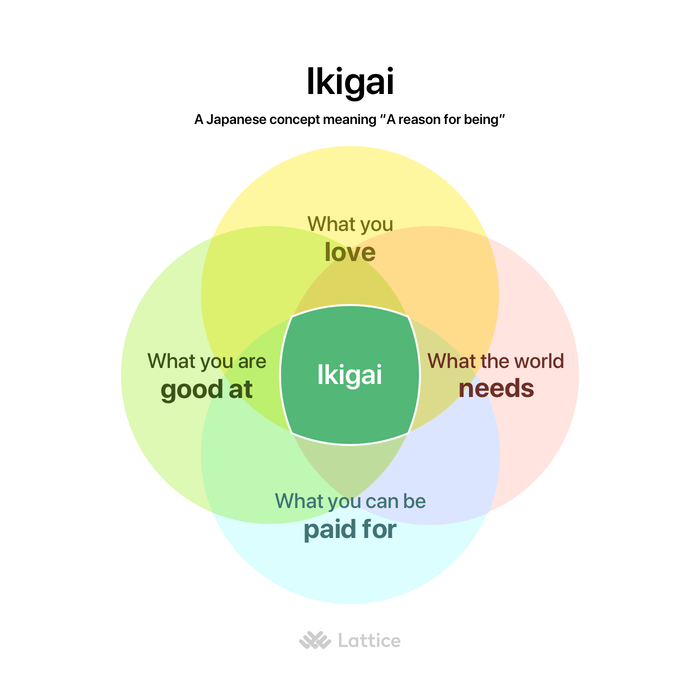Product-market fit is the hard to define but undeniable ‘click’ when a product and its market connect. When you don’t have product-market fit, no amount of process, talent, or strategy will make a company work. When you do have it, almost nothing can stop you. It’s the only thing that matters.
Identifying employee-job fit
There is an analogous concept in management that we might call “employee-job fit” — the hard-to-define but undeniable click that you do or don’t see between an employee and their role, which is related to, but goes beyond, job satisfaction.
There are a lot of frameworks for how to identify strong employee-job fit, but the most generalized one I have seen is from Claire Hughes-Johnson, the COO of Stripe, who said that what you’re looking for is people who are:
- effective (good at what they do)
- impactful (their contributions are significant to the company)
- passionate (intrinsically motivated and enjoy their work)
There is a related Japanese concept called ikigai, which means “the reason you get up in the morning,” and is achieved when what you do is at the intersection between what you’re good at, what you love doing, and what provides value to the world. If that thing also allows you get paid, then it’s a job with ikigai— professional nirvana. Jobs with ikigai mean jobs that are the right fit for the employee.

When there is strong employee-job fit, everyone wins.
A framework for determining your company’s employee-job fit
Anyone whose primary job is to increase the company’s output by improving teams’ effectiveness and company culture (managers and HR teams) should strive to maximize the number of employees at their company who have high employee-job fit.
To figure out your own company’s distribution, you have to know where your employees stand and whether you have the right people in the right roles. It's also important to make sure hiring managers are using screening tools such as very specific interview questions when assessing job applicants, in order to find the best candidate for an open position.
At any given time, you will likely have a normal distribution of the employee-job fit for everyone at your company.

How do figure out your own company’s distribution?
Collecting 360 feedback from managers, peers, and direct reports is one of the most reliable ways to determine where people are on the curve. A job-fit assessment gives a wide range of opinions to help triangulate the truth, it helps reduce the bias of personal relationships, and it allows for a structured and focused dialogue.
A framework of effectiveness, impact, and passion helps you understand your employee-job fit across a company. It also means you are approaching performance management from a place of compassion — trying to help your employees find their reason for getting up in the morning is good not just for the company, but for them, too.
- Effectiveness describes how able a person is to get things done in their job. Highly effective employees are able to get a surprising amount done with relatively low oversight or drama. In certain roles, effectiveness is quite obvious and can be determined primarily through numbers. But when that’s not an option, some telltale signs still exist — the people around them frequently comment on the quality and quantity of their output, go to them with questions, and try to work on projects with them.
- Impact tells you how much influence a person’s work is having, either on customers, coworkers, or the overall business. There is no single way to have high impact; a high performing individual contributor, a manager of many people, or an influential product manager could all have a high impact. Understanding the degree of impact of a person’s role is critical because it tells you how much leverage an employee has on the business; a low-performing person in a high impact role needs to be addressed quickly, while a high performer in a high impact role is a beautiful thing.
- Passion might be a bit of a strong word, but I will say that I have never met an extremely effective person who doesn’t care deeply about their work. When people are passionate about their jobs, working hard is effortless, people come up with thoughtful solutions more often because they are chewing on problems in their minds outside of work, and they tend to spread a positive energetic vibe to everyone they work with. I’ve come to believe that passion is a true competitive advantage.
Figuring out how your team falls out along these dimensions will give you a good idea of who is flourishing or struggling. From there, you can take action to shift your company’s curve to the right.
Employee-job fit has massive upside and massive downside
In venture capital, it is often said that it doesn’t matter if you’re wrong a lot, it just matters that you are sometimes really, really right. The reason for this is because of the nature of equity — you can get 1000x upside or more, but you can only ever lose 1x your investment.
Employee-job fit is different. When you get it right, the upside is high. But unlike venture capital, the cost of getting it wrong is also high.
When you have people in the wrong role, not only are they holding the place of someone who might be extremely effective, but they also demotivate people, around them, generate bad decisions and distractions that affect the people around them, and, if they are a manager, can be a direct cause of top talent quitting your company.
The stakes are high — both for your company’s success and the happiness of everyone who works there — so take the concept seriously and aspire to be great.







